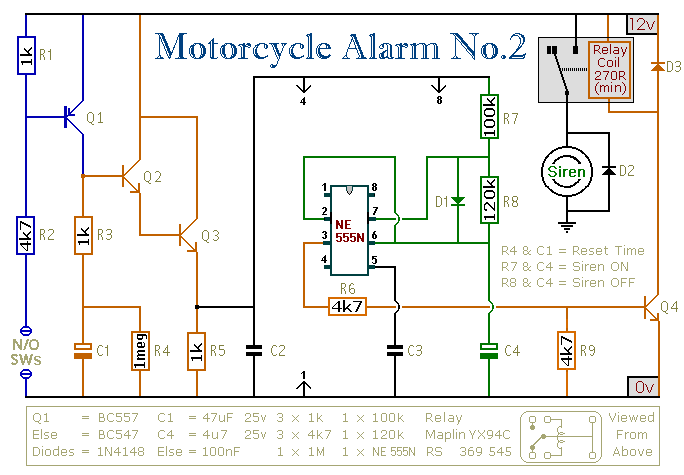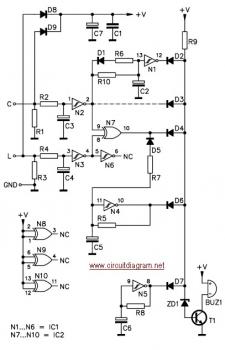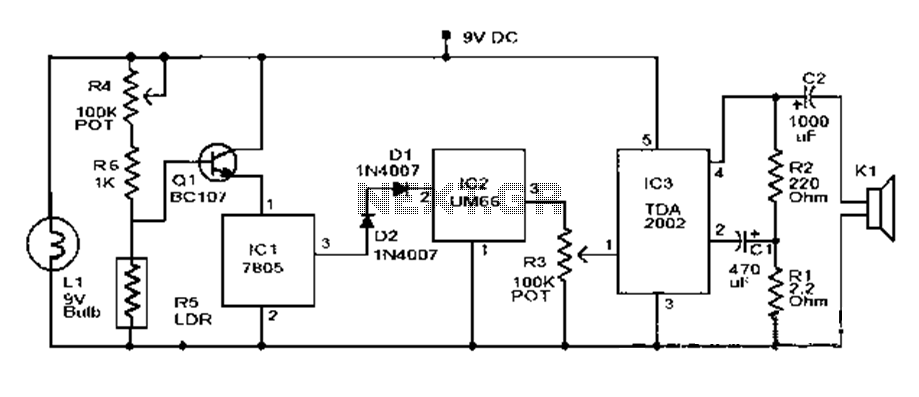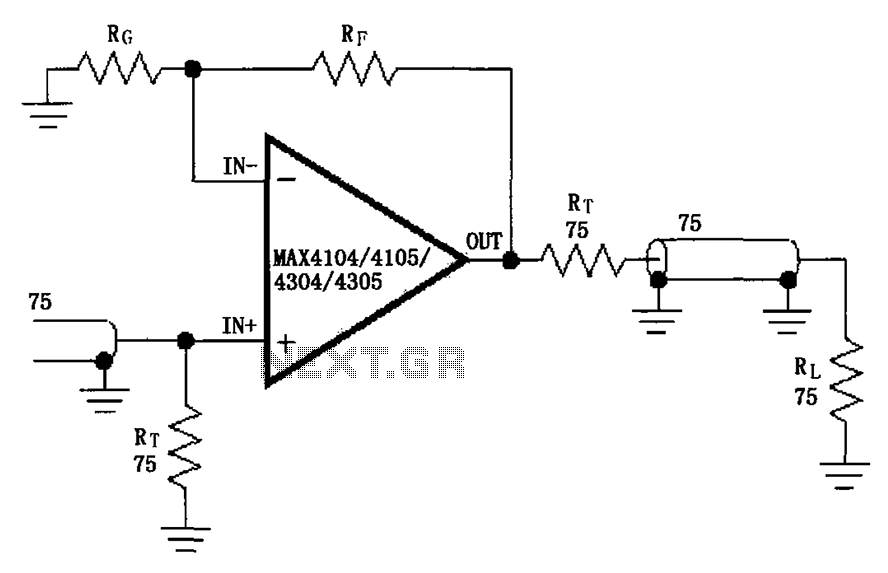
Motorcycle Alarm schematic

This circuit features an intermittent siren output and automatic reset. It can be operated manually using a key-switch or a hidden switch; but it can also be wired to set itself automatically when you turn-off the ignition. By adding external relays you can immobilize the bike, flash the lights etc. Ron has used my Asymmetric Timer as the basis for his design. More: Any number of normally-open switches may be used. Fit "tilt" switches that close when the steering is moved or when the bike is lifted off its side-stand or pushed forward off its centre-stand. Use micro-switches to protect removable panels.
The described circuit is an automotive security system designed for motorcycles, incorporating an intermittent siren output and an automatic reset feature. The circuit can be activated through a key-switch or a concealed switch, providing flexibility in operation. Additionally, it has the capability to automatically engage when the ignition is turned off, enhancing security by ensuring the system is armed without user intervention.
The core of the design utilizes an Asymmetric Timer, which allows for customizable timing intervals for the siren output. This timer can be configured to generate an intermittent sound pattern, thereby drawing attention when unauthorized access is detected. The circuit can be expanded by integrating external relays, which can control various functions such as immobilizing the motorcycle or flashing the lights, thereby increasing the deterrent effect against theft.
The system supports the integration of multiple normally-open switches, which can be strategically placed to enhance security. For instance, tilt switches can be employed to detect movement of the motorcycle, such as when the steering is turned or when the bike is lifted off its side-stand or moved from its center-stand. This feature can trigger the siren if the motorcycle is tampered with. Additionally, micro-switches can be utilized to safeguard removable panels, ensuring that any unauthorized attempts to access critical components are immediately flagged by the alarm system.
The overall design emphasizes user convenience while maintaining a high level of security, making it suitable for motorcycle enthusiasts looking to protect their vehicles effectively. Proper installation and configuration of the switches and relays are crucial for optimal performance and reliability of the system.This circuit features an intermittent siren output and automatic reset. It can be operated manually using a key-switch or a hidden switch; but it can also be wired to set itself automatically when you turn-off the ignition. By adding external relays you can immobilize the bike, flash the lights etc. Ron has used my Asymmetric Timer as the basis for his design. Any number of normally-open switches may be used. Fit "tilt" switches that close when the steering is moved or when the bike is lifted off its side-stand or pushed forward off its centre-stand. Use micro-switches to protect removable panels and 🔗 External reference
The described circuit is an automotive security system designed for motorcycles, incorporating an intermittent siren output and an automatic reset feature. The circuit can be activated through a key-switch or a concealed switch, providing flexibility in operation. Additionally, it has the capability to automatically engage when the ignition is turned off, enhancing security by ensuring the system is armed without user intervention.
The core of the design utilizes an Asymmetric Timer, which allows for customizable timing intervals for the siren output. This timer can be configured to generate an intermittent sound pattern, thereby drawing attention when unauthorized access is detected. The circuit can be expanded by integrating external relays, which can control various functions such as immobilizing the motorcycle or flashing the lights, thereby increasing the deterrent effect against theft.
The system supports the integration of multiple normally-open switches, which can be strategically placed to enhance security. For instance, tilt switches can be employed to detect movement of the motorcycle, such as when the steering is turned or when the bike is lifted off its side-stand or moved from its center-stand. This feature can trigger the siren if the motorcycle is tampered with. Additionally, micro-switches can be utilized to safeguard removable panels, ensuring that any unauthorized attempts to access critical components are immediately flagged by the alarm system.
The overall design emphasizes user convenience while maintaining a high level of security, making it suitable for motorcycle enthusiasts looking to protect their vehicles effectively. Proper installation and configuration of the switches and relays are crucial for optimal performance and reliability of the system.This circuit features an intermittent siren output and automatic reset. It can be operated manually using a key-switch or a hidden switch; but it can also be wired to set itself automatically when you turn-off the ignition. By adding external relays you can immobilize the bike, flash the lights etc. Ron has used my Asymmetric Timer as the basis for his design. Any number of normally-open switches may be used. Fit "tilt" switches that close when the steering is moved or when the bike is lifted off its side-stand or pushed forward off its centre-stand. Use micro-switches to protect removable panels and 🔗 External reference
Warning: include(partials/cookie-banner.php): Failed to open stream: Permission denied in /var/www/html/nextgr/view-circuit.php on line 713
Warning: include(): Failed opening 'partials/cookie-banner.php' for inclusion (include_path='.:/usr/share/php') in /var/www/html/nextgr/view-circuit.php on line 713





